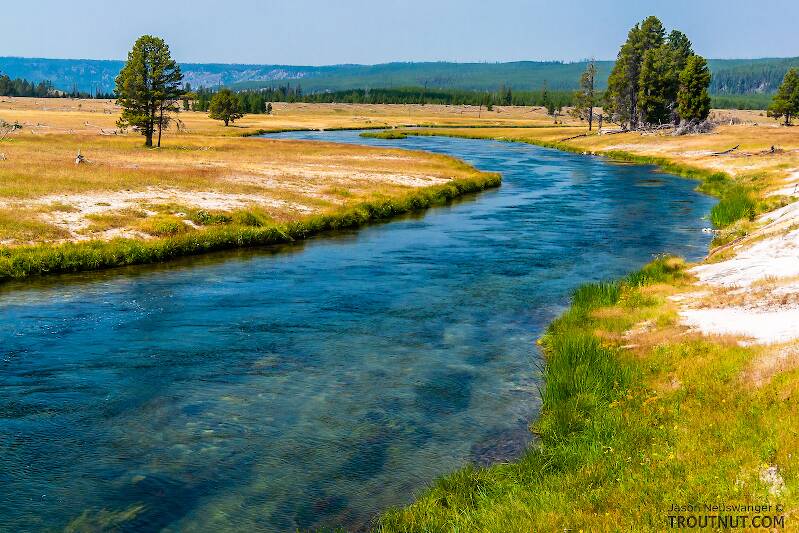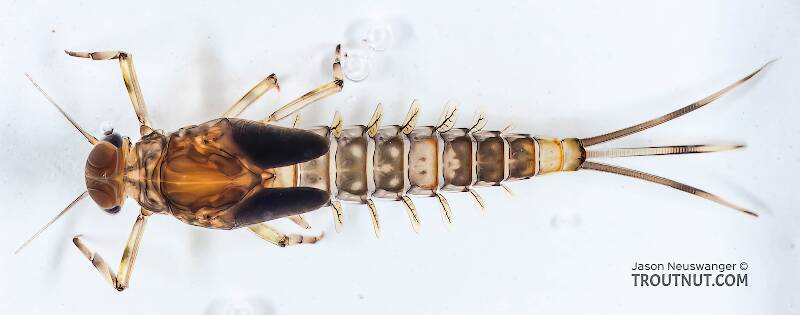
Hex Mayflies
Hexagenia limbata
The famous nocturnal Hex hatch of the Midwest (and a few other lucky locations) stirs to the surface mythically large brown trout that only touch streamers for the rest of the year.
Featured on the forum

This specimen keys to the Epeorus albertae group of species. Of the five species in that group, the two known in Washington state are Epeorus albertae and Epeorus dulciana. Of the two, albertae has been collected in vastly more locations in Washington than dulciana, suggesting it is far more common. On that basis alone I'm tentatively putting this nymph in albertae, with the large caveat that there's no real information to rule out dulciana.

Troutnut is a project started in 2003 by salmonid ecologist Jason "Troutnut" Neuswanger to help anglers and
fly tyers unabashedly embrace the entomological side of the sport. Learn more about Troutnut or
support the project for an enhanced experience here.
Martinlf on Dec 23, 2006December 23rd, 2006, 12:30 pm EST
OK, this olive nymph seems to have a good bit of grey in it. I know colors vary a lot among baetids, but I'm wondering about a good general color for shucks. And nymphs. Are most of them more olive than this? Or is it too hard to generalize? Also, I notice darker and lighter segments in the abdomen. I've noted this in subvaria's and try to get a lighter band just ahead of the darker tail segment in nymphs I tie for them. Perhaps this is a good idea with baetid nymphs as well.
"He spread them a yard and a half. 'And every one that got away is this big.'"
--Fred Chappell
--Fred Chappell
GONZO on Dec 26, 2006December 26th, 2006, 1:28 pm EST
Louis,
Baetidae includes so many species that generalization about color is virtually impossible. Even the common name "blue-winged olive" is a nasty joke. Adult (and nymph) body colors range from yellow to chartreuse to olive to olive-brown to reddish-brown to dark brown. Wing colors vary from very light grey (nearly white) to very dark grey (nearly black). Although color may be less significant in tiny mayflies, the only way to be accurate is to become familiar with local species.
That said, however, this might be one instance where generalized patterns with blended or "spectrumized" dubbing can be very useful. Until patterns based on specific local color variations can be devised, a light and dark "baetis" nymph in useful sizes (say #16-22) will probably serve to fool all but the fussiest trout. Make one dubbing blend lighter and more olive, and the other darker and more brown. A similar approach could be used on duns and shucks (utilizing a darker and lighter blend of all the colors listed in the first paragraph). I think this is a good compromise approach for many genera/species that display wide color variations.
By the way, as an aid to developing more specific imitations, some of the most important local (PA) species are B. tricaudatus, B. intercalaris, Diphetor hageni, Acentrella turbida, and Plauditus punctriventris (listed in my totally subjective order of significance).
Baetidae includes so many species that generalization about color is virtually impossible. Even the common name "blue-winged olive" is a nasty joke. Adult (and nymph) body colors range from yellow to chartreuse to olive to olive-brown to reddish-brown to dark brown. Wing colors vary from very light grey (nearly white) to very dark grey (nearly black). Although color may be less significant in tiny mayflies, the only way to be accurate is to become familiar with local species.
That said, however, this might be one instance where generalized patterns with blended or "spectrumized" dubbing can be very useful. Until patterns based on specific local color variations can be devised, a light and dark "baetis" nymph in useful sizes (say #16-22) will probably serve to fool all but the fussiest trout. Make one dubbing blend lighter and more olive, and the other darker and more brown. A similar approach could be used on duns and shucks (utilizing a darker and lighter blend of all the colors listed in the first paragraph). I think this is a good compromise approach for many genera/species that display wide color variations.
By the way, as an aid to developing more specific imitations, some of the most important local (PA) species are B. tricaudatus, B. intercalaris, Diphetor hageni, Acentrella turbida, and Plauditus punctriventris (listed in my totally subjective order of significance).
Quick Reply
Related Discussions
Topic
Replies
Last Reply
0
Jun 29, 2020
by Wiflyfisher
by Wiflyfisher



